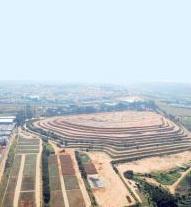Due to the full implementation of the thermoelectric power plants system, 20 percent of the greenhouse effect gases produced by solid waste will be neutralized. That means that it will prevent the emission of eleven-million tons of CO2, which equals to the emissions of two-million oil fueled vehicles, by 2012.
In this sense, the landfills were able to generate Certificates of Emission Reductions (CERs) through the Clean Development Mechanism (CDM) conceived by the Kyoto Protocol. By December 2007, 2.8 million units of CERs had already been officially registered, stemming from the Bandeirantes landfill waste management project.
The Bandeirantes landfill will generate eight-million carbon credits by 2012. In its first bid in the carbon credit market, Sao Paulo raised more than twelve-million Euros for roughly 800,000 carbon credits negotiated at €16.20 per equivalent ton of carbon. The resources obtained from the negotiation will be invested in environmental projects in the neighboring areas of the landfills.
On February 21st, 2009, two leisure squares, Cuitegi and Mogeiro, in the borough of Perus, surrounding Bandeirantes landfill, were inaugurated by Mayor Gilberto Kassab.
The Cuitegi Square has 2,300m² of leisure area, playgrounds, benches and the Sao Paulo City Hall preserved fruit trees planted by local dwellers. Also, the area connected two streets that had no prior linkage, facilitating mobility within the local community. The Mogeiro Square has 6,897m² of leisure area and offers a walking path, gym station, playground, benches and a community space.
Besides these implemented initiatives there are other projects that will be funded by the raised money. One of the most important is the re-urbanization of an illegally occupied area under the Slum Upgrading Program, which besides the regularization works counts with a program for environmental education. The other is the construction of two linear parks to contain rain water and reduce recurrent floods in the area.
It was the first time carbon credits were negotiated in the market through an auction at the Brazilian Mercantile & Futures Exchange (BM&F). A second auction of the resulting carbon credits took place in September 2008. On this occasion, the 713 metric tons of CO2 equivalents were bought at a rate of €19.20 each, resulting in an income of almost fourteen-million Euros. A third auction is being planned and should take place by the end of 2009.



